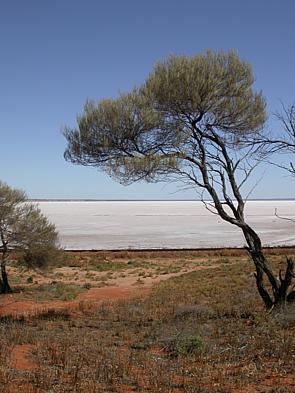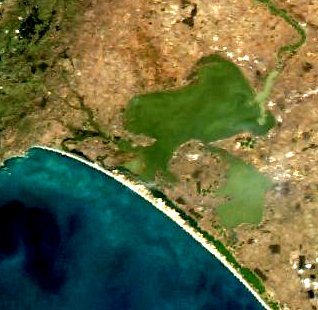
The Murray River is a river in Southeastern Australia. It is Australia's longest river at 2,508 km (1,558 mi) extent. Its tributaries include five of the next six longest rivers of Australia. Together with that of the Murray, the catchments of these rivers form the Murray–Darling basin, which covers about one-seventh the area of Australia. It is widely considered Australia's most important irrigated region.

Crayfish are freshwater crustaceans belonging to the infraorder Astacidea, which also contains lobsters. Taxonomically, they are members of the superfamilies Astacoidea and Parastacoidea. They breathe through feather-like gills. Some species are found in brooks and streams, where fresh water is running, while others thrive in swamps, ditches, and paddy fields. Most crayfish cannot tolerate polluted water, although some species, such as Procambarus clarkii, are hardier. Crayfish feed on animals and plants, either living or decomposing, and detritus.

The Murray cod is a large Australian predatory freshwater fish of the genus Maccullochella in the family Percichthyidae. Although the species is called a cod in the vernacular, it is not related to the Northern Hemisphere marine cod (Gadus) species. The Murray cod is an important part of Australia's vertebrate wildlife—as an apex predator in the Murray-Darling River system—and also significant in Australia's human culture. The Murray cod is the largest exclusively freshwater fish in Australia, and one of the largest in the world. Other common names for Murray cod include cod, greenfish, goodoo, Mary River cod, Murray perch, ponde, pondi and Queensland freshwater cod.

The Lake Eyre basin is a drainage basin that covers just under one-sixth of all Australia. It is the largest endorheic basin in Australia and amongst the largest in the world, covering about 1,200,000 square kilometres (463,323 sq mi), including much of inland Queensland, large portions of South Australia and the Northern Territory, and a part of western New South Wales. The basin is also one of the largest, least-developed arid zone basins with a high degree of variability anywhere. It supports only about 60,000 people and has no major irrigation, diversions or flood-plain developments. Low density grazing that sustains a large amount of wildlife is the major land use, occupying 82% of the total land within the basin. The Lake Eyre basin of precipitation to a great extent geographically overlaps the Great Artesian Basin underneath.

The Murray–Darling Basin is a large geographical area in the interior of southeastern Australia, encompassing the drainage basin of the tributaries of the Murray River, Australia's longest river, and the Darling River, a right tributary of the Murray and Australia's third-longest river. The Basin, which includes six of Australia's seven longest rivers and covers around one-seventh of the Australian landmass, is one of the country's most significant agricultural areas providing one-third of Australia's food supply. Located west of the Great Dividing Range, it drains southwest into the Great Australian Bight and spans most of the states of New South Wales and Victoria, the Australian Capital Territory, and parts of the states of Queensland and South Australia.

Lake Alexandrina is a coastal freshwater lake located between the Fleurieu and Kangaroo Island and Murray and Mallee regions of South Australia, about 100 kilometres (62 mi) south-east of Adelaide. The lake adjoins the smaller Lake Albert and a coastal lagoon called The Coorong to its southeast, before draining into the Great Australian Bight via a short, narrow opening known as Murray Mouth.

The Paroo River, a series of waterholes, connected in wet weather as a running stream of the Darling catchment within the Murray–Darling basin, is located in the South West region of Queensland and Far West region of New South Wales, Australia. It is the home of the Paarkantji people.

The golden perch is a medium-sized, yellow or gold-coloured species of Australian freshwater fish found primarily in the Murray-Darling River system, though a subspecies is found in the Lake Eyre-Cooper Creek system, and another subspecies, suspected to be ancestral to all other populations, is found in the Fitzroy River system in Queensland. Other common names for golden perch are "goldens", “yellowbelly” and "callop", the last generally used only in South Australia.

The silver perch is a medium-sized freshwater fish of the family Terapontidae endemic to the Murray-Darling river system in south-eastern Australia.
The Murray–Darling Basin Authority (MDBA) is the principal government agency in charge of managing the Murray–Darling Basin in an integrated and sustainable manner. The MDBA is an independent statutory agency that manages, in conjunction with the Basin states, the Murray–Darling basin's water resources in the national interest. The MDBA reports to the Australian Government Minister for the Environment and Water, held since June 2022 by the Hon Tanya Plibersek.
Freshwater bivalves are one kind of freshwater mollusc, along with freshwater snails. They are bivalves that live in fresh water as opposed to salt water, which is the main habitat type for bivalves.

Hyriidae is a taxonomic family of pearly freshwater mussels, aquatic bivalve molluscs in the order Unionida. This family is native to South America, Australia, New Zealand and New Guinea. Like all members of that order, they go through a larval stage that is parasitic on fish.

The Paroo-Darling National Park is a protected national park that is located in the Far West region of New South Wales, in eastern Australia. The 178,053-hectare (439,980-acre) national park spans two distinct regions in the outback area. This region covers the arid catchments of the Paroo River and the Paroo-Darling confluence to the south.

The Barmah National Park, formerly Barmah State Park, is a national park located in the Hume region of the Australian state of Victoria. The park is located adjacent to the Murray River near the town of Barmah, approximately 225 kilometres (140 mi) north of Melbourne. The park consists of river red gum floodplain forest, interspersed with treeless freshwater marshes. The area is subject to seasonal flooding from natural and irrigation water flows.

The Great Darling Anabranch, commonly called the Darling Anabranch, is an anabranch and ancestral path of the Darling River in the lower Murray-Darling basin in the Far West and Riverina regions of New South Wales, Australia.

The southern pygmy perch, also known as the Tasmanian pygmy perch, is a species of freshwater ray-finned fish, a temperate perch from the family Percichthyidae which is native to south-eastern Australia and Tasmania.

Velesunio is a genus of medium to large sized mussels in the family Hyriidae.

Velesunio wilsonii is a species of freshwater mussel endemic to Australia and comes from the Hyriidae family. Velesunio wilsonii mussels have a thick, dark shell that are sometimes flaky and mostly closed. Velesunio wilsonii have a fleshy foot that sometimes extends outside of the valves. The shell of the Velesunio wilsonii varies from oblong to a symmetrical circle. Velesunio wilsonii size ranges from 40 mm to 120 mm.

Pseudoraphis spinescens, called spiny mudgrass or Moira grass is a rhizomatous and stoloniferous aquatic or semi-aquatic perennial grass, with ascending stems forming loose, floating mats in water to 1 m deep or more, or with stems to 50 cm high when not submerged. Moira grass was first described in 1810 by Robert Brown as Panicum spinescens, and subsequently transferred to Pseudoraphis by Joyce W. Vickery in 1950.
Alathyria condola is a species of freshwater river mussel, a bivalve mollusk in the family Hyriidae. This species occurs in coastal rivers in eastern New South Wales, Australia. The type specimen was collected from the Murrumbidgee River.



















